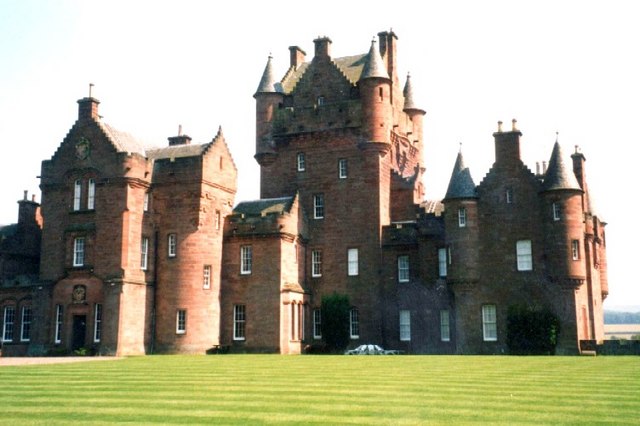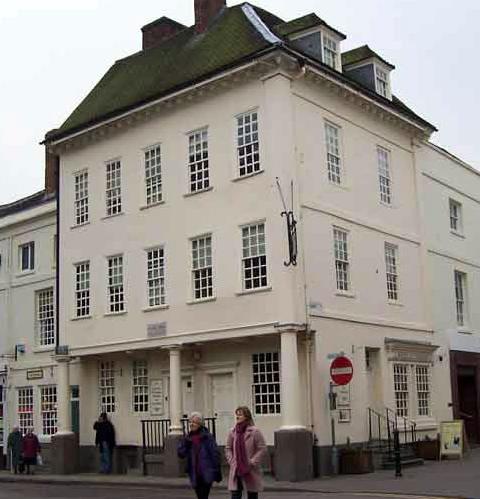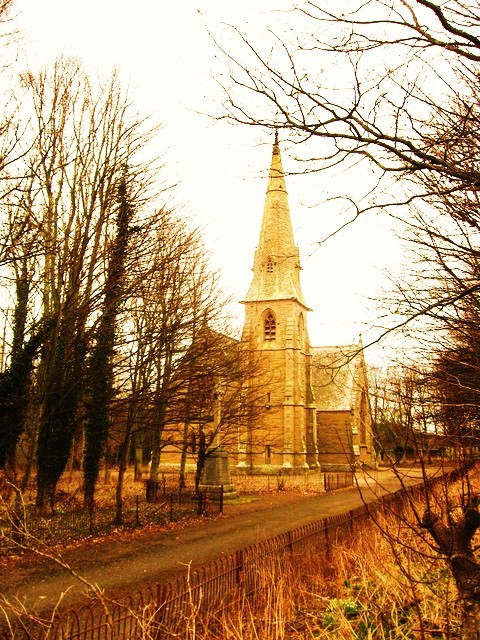|
Ayton, Scottish Borders
Ayton is a small village located in the historic county of Berwickshire, today part of the Scottish Borders region. It is on the Eye Water, from which it is said to take its name: Ayton means 'Eye-town'. It contains the former ancient tollbooth or town hall with a clock tower, the Hemelvaart Bier Cafe (an entertainment venue as well as a bar) and a village store. It is located near the East Coast Main Line railway line, which runs between London, King's Cross and Edinburgh, Waverley station, the closest station being Reston station. The A1 (Great North Road) originally ran through the heart of the village, but during the 1980s a bypass was built to the East of the village. Ayton was the location of a coaching inn on the road between London and Edinburgh. Ayton Castle and church The splendid edifice of Ayton Castle, the '' caput'' of the Scottish feudal barony of Ayton, dominates the town and district. It is built around a peel tower, a stronghold of the Home family, w ... [...More Info...] [...Related Items...] OR: [Wikipedia] [Google] [Baidu] |
Scottish Borders
The Scottish Borders ( sco, the Mairches, 'the Marches'; gd, Crìochan na h-Alba) is one of 32 council areas of Scotland. It borders the City of Edinburgh, Dumfries and Galloway, East Lothian, Midlothian, South Lanarkshire, West Lothian and, to the south-west, south and east, the English counties of Cumbria and Northumberland. The administrative centre of the area is Newtown St Boswells. The term Scottish Borders, or normally just "the Borders", is also used to designate the areas of southern Scotland and northern England that bound the Anglo-Scottish border. Geography The Scottish Borders are in the eastern part of the Southern Uplands. The region is hilly and largely rural, with the River Tweed flowing west to east through it. The highest hill in the region is Broad Law in the Manor Hills. In the east of the region, the area that borders the River Tweed is flat and is known as 'The Merse'. The Tweed and its tributaries drain the entire region with the rive ... [...More Info...] [...Related Items...] OR: [Wikipedia] [Google] [Baidu] |
Clan Home
Clan Home (pronounced and sometimes spelt Hume) is a Scottish clan.Way, George and Squire, Romily. ''Collins Scottish Clan & Family Encyclopedia''. (Foreword by The Rt Hon. The Earl of Elgin KT, Convenor, The Standing Council of Scottish Chiefs). Published in 1994. Pages 168 – 169. It held immense power for much of the Middle Ages and dominated the eastern Scottish Borders. It produced no fewer than eight Wardens of the Eastern March – more than any other family. History Origins of the clan The Home family descends in the male-line from Cospatric I (died after 1073), the Anglo-Celtic Earl of Northumbria. His descendant William de Home (son of Sir Patrick de Greenlaw, the second son of Cospatric III, Earl of Lothian), adopted the surname following his acquisition of the lands of Home in Berwickshire in the early 13th century, through his marriage to his second cousin Ada (the daughter of Patrick I, Earl of Dunbar). William's arms featured the silver lion of Dunbar but with ... [...More Info...] [...Related Items...] OR: [Wikipedia] [Google] [Baidu] |
Negus (drink)
Negus is a drink made of wine, often port, mixed with hot water, oranges or lemons, spices and sugar. History According to Malone (''Life of Dryden'', Prose Work. i - p. 484) this drink was invented in the early 18th Century by Col. Francis Negus (d.1732), a British courtier (commissioner for executing the office of Master of the Horse from 1717 to 1727, then Master of the Buckhounds). James Boswell refers to it repeatedly in his '' London Journal''. Negus is also referred to in ''Jane Eyre'' by Charlotte Brontë, when Jane drinks it on arrival at Thornfield Hall. Jane Austen mentions it as part of the fare at a ball in ''Mansfield Park.'' In ''Wuthering Heights'' by Emily Brontë, Catherine is given it at Thrushcross Grange by the Lintons; it appears in several works by Charles Dickens, namely ''Sketches by Boz'', ''The Pickwick Papers'', '' A Christmas Carol'' (during the party at Fezziwig's), ''Dombey and Son'', ''David Copperfield'', ''Our Mutual Friend'' and ''Bleak Hou ... [...More Info...] [...Related Items...] OR: [Wikipedia] [Google] [Baidu] |
Berwick-upon-Tweed
Berwick-upon-Tweed (), sometimes known as Berwick-on-Tweed or simply Berwick, is a town and civil parish in Northumberland, England, south of the Anglo-Scottish border, and the northernmost town in England. The 2011 United Kingdom census recorded Berwick's population as 12,043. The town is at the mouth of the River Tweed on the east coast, south east of Edinburgh, north of Newcastle upon Tyne, and north of London. Uniquely for England, the town is slightly further north than Denmark's capital Copenhagen and the southern tip of Sweden further east of the North Sea, which Berwick borders. Berwick was founded as an Anglo-Saxon settlement in the Kingdom of Northumbria, which was annexed by England in the 10th century. A civil parish and town council were formed in 2008 comprising the communities of Berwick, Spittal and Tweedmouth. It is the northernmost civil parish in England. The area was for more than 400 years central to historic border wars between the Kingdoms of Eng ... [...More Info...] [...Related Items...] OR: [Wikipedia] [Google] [Baidu] |
Chaise
A one-horse chaise A three-wheeled "Handchaise", Germany, around 1900, designed to be pushed by a person A chaise, sometimes called chay or shay, is a light two- or four-wheeled traveling or pleasure carriage for one or two people with a folding hood or calash top. The name, in use in England before 1700, came from the French word "chaise" (meaning "chair") through a transference from a sedan-chair to a wheeled vehicle. Design The two-wheeled version, usually of a chair-backed type, for one or two persons, also called a '' gig'' or '' one-horse shay'', had a body hung on leather straps or thorough-braces and was usually drawn by one horse; a light chaise having two seats was a ''double chair''. A ''chaise-cart'' was a light carriage fitted with suspension, used for transporting lightweight goods. A '' bath chair'' was a hooded and sometimes glassed wheeled chair used especially by invalids; it could be drawn by a horse or pushed by an attendant. Other types of chaise in ... [...More Info...] [...Related Items...] OR: [Wikipedia] [Google] [Baidu] |
London Journal
James Boswell's ''London Journal'' is a published version of the daily journal he kept between the years 1762 and 1763 while in London. Along with many more of his private papers, it was found in the 1920s at Malahide Castle in Ireland, and was first published in 1950, in an edition by Frederick A. Pottle. In it, Boswell, then a young Scotsman of 22, visits London for his second time. One of the most notable events in the journal is Boswell's meeting on 16 May, 1763 Samuel Johnson, the famous writer, moralist, and lexicographer with whom Boswell would form a close relationship, eventually writing the biography ''The Life of Samuel Johnson.'' The journal relates with much detail and candour his frequent and casual use of prostitutes. One of the more notorious events related is Boswell's meeting his mistress Louisa, whom he believes has given him gonorrhea: BOSWELL. Pray, Madam, in what state of health have you been in for some time? LOUISA. Sir, you amaze me. BOSWELL. I have ... [...More Info...] [...Related Items...] OR: [Wikipedia] [Google] [Baidu] |
Samuel Johnson
Samuel Johnson (18 September 1709 – 13 December 1784), often called Dr Johnson, was an English writer who made lasting contributions as a poet, playwright, essayist, moralist, critic, biographer, editor and lexicographer. The ''Oxford Dictionary of National Biography'' calls him "arguably the most distinguished man of letters in English history". Born in Lichfield, Staffordshire, he attended Pembroke College, Oxford until lack of funds forced him to leave. After working as a teacher, he moved to London and began writing for ''The Gentleman's Magazine''. Early works include '' Life of Mr Richard Savage'', the poems ''London'' and '' The Vanity of Human Wishes'' and the play ''Irene''. After nine years' effort, Johnson's '' A Dictionary of the English Language'' appeared in 1755, and was acclaimed as "one of the greatest single achievements of scholarship". Later work included essays, an annotated ''The Plays of William Shakespeare'', and the apologue '' The History of ... [...More Info...] [...Related Items...] OR: [Wikipedia] [Google] [Baidu] |
James Boswell
James Boswell, 9th Laird of Auchinleck (; 29 October 1740 ( N.S.) – 19 May 1795), was a Scottish biographer, diarist, and lawyer, born in Edinburgh. He is best known for his biography of his friend and older contemporary the English writer Samuel Johnson, which is commonly said to be the greatest biography written in the English language. A great mass of Boswell's diaries, letters and private papers were recovered from the 1920s to the 1950s, and their ongoing publication by Yale University has transformed his reputation. Early life Boswell was born in Blair's Land on the east side of Parliament Close behind St Giles' Cathedral in Edinburgh on 29 October 1740 ( N.S.). He was the eldest son of a judge, Alexander Boswell, Lord Auchinleck, and his wife Euphemia Erskine. As the eldest son, he was heir to his family's estate of Auchinleck in Ayrshire. Boswell's mother was a strict Calvinist, and he felt that his father was cold to him. As a child, he was delicate. Kay Jamison, P ... [...More Info...] [...Related Items...] OR: [Wikipedia] [Google] [Baidu] |
Diarist
A diary is a written or audiovisual record with discrete entries arranged by date reporting on what has happened over the course of a day or other period. Diaries have traditionally been handwritten but are now also often digital. A personal diary may include a person's experiences, thoughts, and/or feelings, excluding comments on current events outside the writer's direct experience. Someone who keeps a diary is known as a diarist. Diaries undertaken for institutional purposes play a role in many aspects of human civilization, including government records (e.g. ''Hansard''), business ledgers, and military records. In British English, the word may also denote a preprinted journal format. Today the term is generally employed for personal diaries, normally intended to remain private or to have a limited circulation amongst friends or relatives. The word "journal" may be sometimes used for "diary," but generally a diary has (or intends to have) daily entries (from the Latin w ... [...More Info...] [...Related Items...] OR: [Wikipedia] [Google] [Baidu] |
Ian Liddell-Grainger
Ian or Iain is a name of Scottish Gaelic origin, derived from the Hebrew given name (Yohanan, ') and corresponding to the English name John. The spelling Ian is an Anglicization of the Scottish Gaelic forename ''Iain''. It is a popular name in Scotland, where it originated, as well as other English-speaking countries. The name has fallen out of the top 100 male baby names in the United Kingdom, having peaked in popularity as one of the top 10 names throughout the 1960s. In 1900, Ian was the 180th most popular male baby name in England and Wales. , the name has been in the top 100 in the United States every year since 1982, peaking at 65 in 2003. Other Gaelic forms of "John" include "Seonaidh" ("Johnny" from Lowland Scots), "Seon" (from English), "Seathan", and "Seán" and " Eoin" (from Irish). Its Welsh counterpart is Ioan, its Cornish equivalent is Yowan and Breton equivalent is Yann. Notable people named Ian As a first name (alphabetical by family name) * Ian Agol ( ... [...More Info...] [...Related Items...] OR: [Wikipedia] [Google] [Baidu] |
Northumberland
Northumberland () is a ceremonial counties of England, county in Northern England, one of two counties in England which border with Scotland. Notable landmarks in the county include Alnwick Castle, Bamburgh Castle, Hadrian's Wall and Hexham Abbey. It is bordered by land on three sides; by the Scottish Borders, Scottish Borders region to the north, County Durham and Tyne and Wear to the south, and Cumbria to the west. The fourth side is the North Sea, with a stretch of coastline to the east. A predominantly rural area, rural county with a landscape of moorland and farmland, a large area is part of Northumberland National Park. The area has been the site of a number of historic Anglo-Scottish wars, battles with Scotland. Name The name of Northumberland is recorded as ''norð hẏmbra land'' in the Anglo-Saxon Chronicle, meaning "the land north of the Humber". The name of the kingdom of ''Northumbria'' derives from the Old English meaning "the people or province north of th ... [...More Info...] [...Related Items...] OR: [Wikipedia] [Google] [Baidu] |
Ayton Parish Church
Ayton and Burnmouth Parish Church is a member church ( sco, kirk) of the Church of Scotland, serving the communities of Ayton and Burnmouth in the Scottish Borders. The church is situated on the side of the B6355 road, just off the main A1 road, south of the village centre and north-west of Berwick upon Tweed, at . History There are charters of the late 11th and early 12th centuries granting the lands of Eiton, as Ayton was then known, to Coldingham Priory. The lands were granted by King Edgar of Scotland (ruled 1097–1107). By the end of the 12th century, the monks of Coldingham had built a chapel dedicated St. Dionysius. The church later received an altar dedicated to the Virgin Mary, with endowments of various acres and rigs in the Lordship of Ayton. The old chapel, which had been extensively altered and renewed over the years up to the 18th century was, originally, a simple rectangular building, but changed to a T shape with the addition of the north aisle. Many of th ... [...More Info...] [...Related Items...] OR: [Wikipedia] [Google] [Baidu] |





